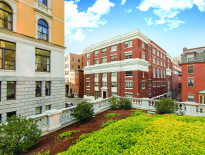The commercial real estate recovery that started in the Cambridge-Boston market and then extended to Route 128 has finally taken hold in the areas along Interstate 495, as companies increasingly push west in search of affordable and available space for expansion.
No one is declaring that the 495 market has fully recovered from the one-two punches of the recent recession followed by the very distinct trend of workers and companies preferring to locate in more urban “live, work, play” settings in and around Boston.
The vacancy rates in the 495 area – generally subdivided into 495 North, 495 West (near the Mass. Turnpike) and 495 South – largely remain above their pre-recession levels.
Still, Class A spaces in all three 495 subsectors are starting to fill up fast and rents are correspondingly inching up, in some cases even matching their highest levels since 2008, or about $22 per square feet.
“We’re getting near the top,” said Chase Bourdelaise, director of research for the Northeast region of Transwestern RBJ. “Things are definitely improving.”
The most impressive area along 495 has reliably been the Framingham-Natick market, where the direct vacancy rate last quester fell to about 18.2 percent and prices were hovering around $19 per square foot, according to data from Jones Lang LaSalle. Digging deeper into the stats, it’s clear Class A office properties are driving the Framingham-Natick market, with a vacancy rate of 14.7 percent and leases hovering around $21 per square foot.
By comparison, the total direct vacancy rate in 495 North is running at about 24.6 percent and asking prices are about $2 below the averages in western 495. The 495 South area has a vacancy rate of 13.1 percent, but its total supply of only 2.2 million square feet of space is dwarfed by the total 12 million square feet in 495 West and 15.5 million in 495 North.
Phil DeSimone, managing director of Boston’s brokerage group at JLL, said he’s particularly impressed with the growth of life-science companies into the 495 area, especially in 495 West. Recently, GE Healthcare announced it was relocating its 500-employees life-sciences headquarters to 200 Forest Street in Marlborough, in the same building where Quest Diagnostics moved into two years ago.
Dozens of other life-science companies, including Boston Scientific, now call Marlborough their home, according to industry officials.
“That entire area is quickly changing,” said DeSimone of the general Marlborough, Westborough and Framingham markets’ attraction to life-science firms. “We are definitely seeing a change.”
All Eyes On The Clock
One closely watched 495 redevelopment, or rather a repositioning, is the recent moves at Maynard’s old Clock Tower complex, recently purchased at a forfeiture auction by Saracen Properties of Waltham and Artimus Real Estate Partners of Chevy Chase, Maryland.
The new owners of the 1.1 million-square-foot complex, which once housed the former Digital Equipment Corp., recently signed up Stratus Technologies to 102,000 square feet of space, bringing the total leased space at Clock Tower to 35 percent. That occupancy rate may not sound terribly impressive, but the new owners say that it’s just the beginning and that they’re confident they can attract plenty more tenants to the sprawling 18-building complex sitting right next to downtown Maynard.
Indeed, the owners have tentative plans to add new retail and restaurants at Clock Tower, as part of an overall plan to open up the complex to the public and closely knit it into the fabric of Maynard’s small-but-quaint downtown. The owners are also contemplating new housing on some surface parking lots, but any housing move, if it ever happens, is still years away.
“We’re working on a master plan right now,” said Travis Powell, a principal at Saracen Properties. “We want to add to what’s already in the downtown, not distract from it.”
JLL’s DeSimone said pumping more life and activities into Clock Tower would be a big boost for the area. “If the new owners make it work, it will spread out to other areas of 495,” he said.
The 495 market’s slow but steady recovery is providing new sale opportunities for property owners and investors – and not just within the office submarket.
In June, Hackman Capital Partners and Calare Properties sold the former Evergreen Solar factory in Devens for $36 million to Artemis Real Estate, the same firm that’s the new co-owner of Clock Tower. Hackman and Calare had purchased the former Evergreen plant out of bankruptcy for $8.3 million in 2012.
Bryan Blake, president of Calare, said the entire 495 area is becoming attractive for all types of tenants and investors, many of them “getting pushed further out” beyond 128 due to high prices in the immediate Boston area.
“We’re seeing more institutional money coming into the 495 rings, across all asset classes,” said Blake, whose company owns and operates about 15.3 million square feet of properties, about 35 percent of which are in the 495 area. “The demand for space is up and availability is down.”










